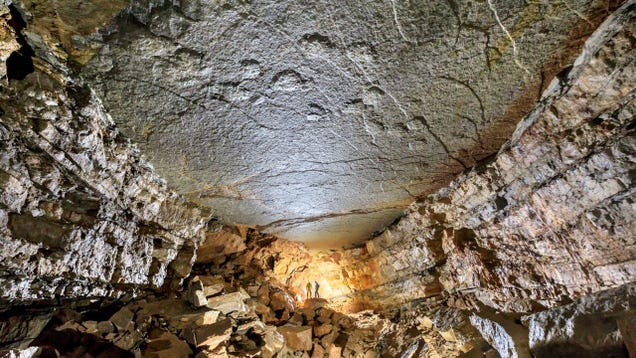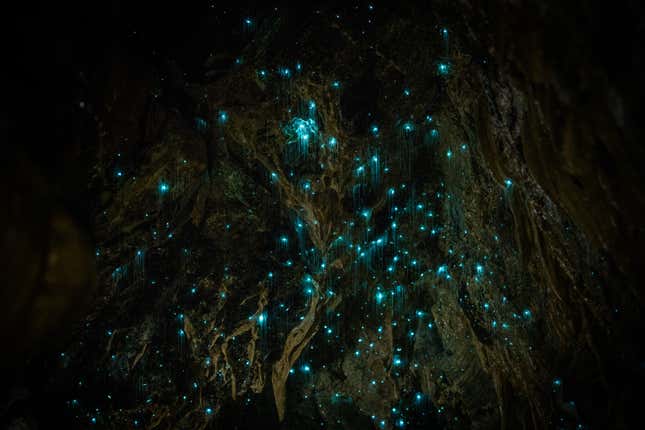The wildest cave systems on Earth

Shelters of our ancestors, galleries for our artwork, hiding places for our treasures, portals to the underworld. Caves have meant many things for human culture through the ages, and still capture the imagination with their inextricable passageways and impossibly large caverns.
Some caves are so alien from the land aboveground that one can feel as though they’re part of another world, or they are (at the least) arenas forbidden to humankind. The following caves are known for their size, for their age, or for the things, living and dead, that have made their mark on the Earth’s underbelly.

This unique, 30-million-year-old limestone cave in New Zealand is famous for one, obvious reason: in the darkness, the cave’s ceiling is illuminated with the eerie blue-white glow of Arachnocampa luminosa—the glowworm. Actually the larval and imago stages of a gnat, the worm’s glow turns Waitomo Cave into a starry sky underground. There’s nothing quite like it.
Vietnam’s Hang Sơn Đoòng belongs to another world. Situated in Phong Nha-Ke Bang National Park, the cave’s main cavern is 650 feet high and three miles long. It is the world’s largest cave, and was only properly explored for the first time on record in 2009. It is amazing how such a massive structure could hide away for so long.

Chile’s marble caves are only accessible by boat. After all, they were forged by water. The caves are the product of waves from Lake General Carrera—a large glacial lake on the Chile-Argentina border— washing up against the calcium carbonate cliffside rock, carving out a dazzling blue-white labyrinth that reflects the blue of the water it abuts. According to Atlas Obscura, the caves took at least 6,000 years to form—practically no time, as far as geological history goes.
The truth is, any one of these caves could be your number one cave. I just didn’t select the Cave of the Crystals because it would’ve been cliché. I mean, look at the gypsum. These massive crystals formed as groundwater in the cave was heated by a magma chamber further beneath the Earth. The water was abundant in anhydrite, which dissolved into gypsum. Some of the crystals are 36 feet long and weigh up to 55 tons, according to National Geographic.
Speaking of cliché, yes. I am including the deepest cave in the world on this list. But can you blame me? Part of the wonder—and indeed, terror—of the world’s subterranean spaces is their depths.
Veryovkina Cave is in Abkhazia, an internationally recognized part of Georgia. The cave is over 7,200 feet deep; the image above shows the cave’s largest shaft. It takes nearly a week to traverse the cave to the bottom and back, and if you refer to the below image, you can see how labyrinthine the cave passageways become deep under the mountain.
South Africa’s Sudwala Caves are ancient; they formed about 240 million years ago, hundreds of millions of years before T. rex was a twinkle in the eye of deep time. Sudwala is mostly formed from dolomite, but also some chert and limestone. Some of the large rock formations in the cave—caused as water in the cave drips and dries, are nearly as old as the cave itself. There are also fossils in the cave—stromatolites, one of the earliest forms of life—making the cave a testament to not only Earth’s history, but that of life itself.
If you find this view badass, hold onto your hat: this is the inside of a volcano’s magma chamber. It is the only volcano in the world where humans can actually enter the chamber. Talk about forbidden—even the image above feels like someone entering the belly of some primordial beast, which is essentially what a volcano is. Thrihnukagigur hasn’t erupted for about 4,500 years, but that doesn’t make the magma chamber any less awesome.
About 166 million years ago, some of the largest dinosaurs to ever roam the planet took a walk along the seaside in what is now France. When they left, their footprints remained, eventually turning to stone. Geological processes shook up that ancient beach, creating a cavern beneath where the animals—titanosaurs—roamed, leaving what you see above: dinosaur tracks on the ceiling of a natural cavern. To me, the trace fossil footprints in Castelbouc Cave reflect what caves are: a window to the past, which show us how different the world once was to what it is today…at least aboveground.


